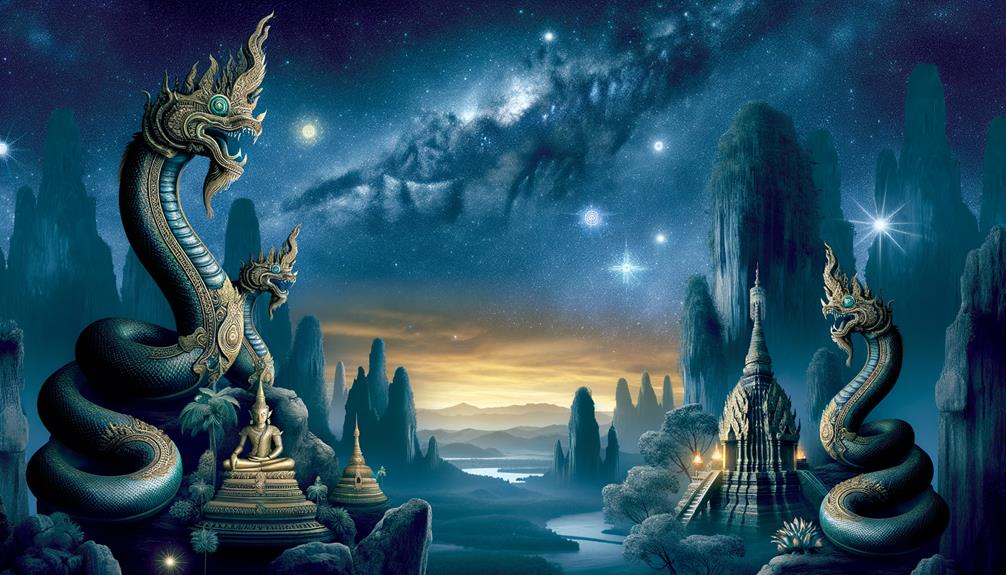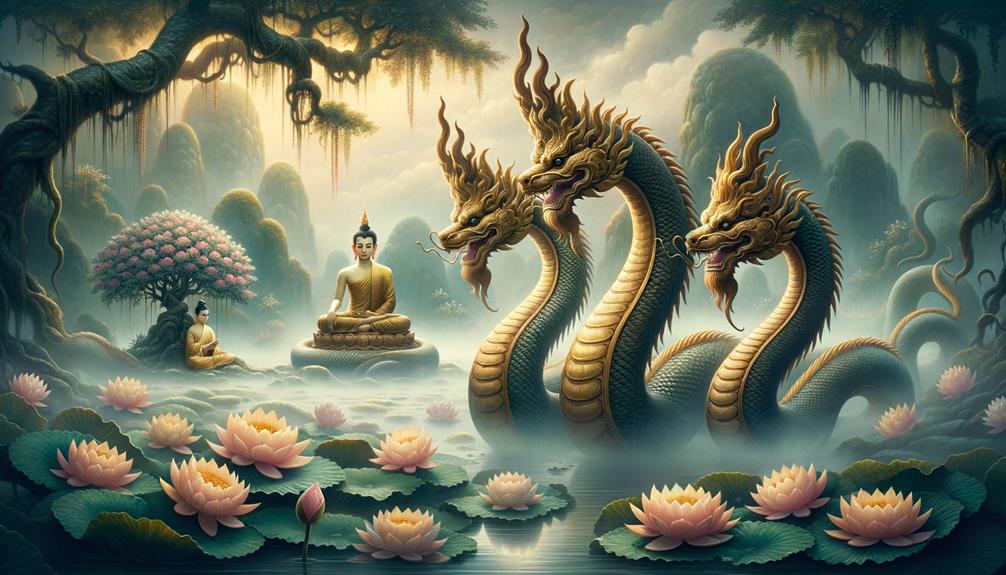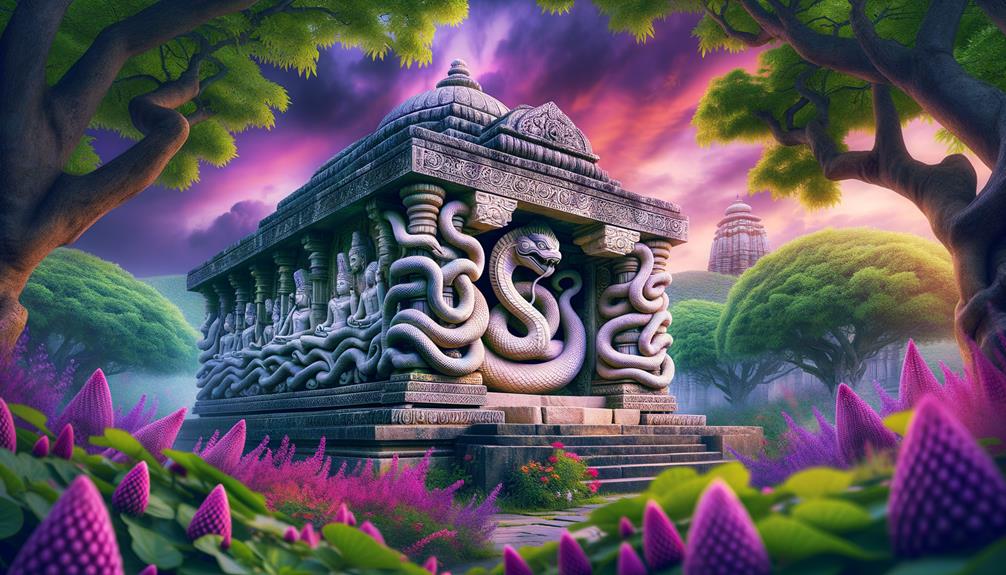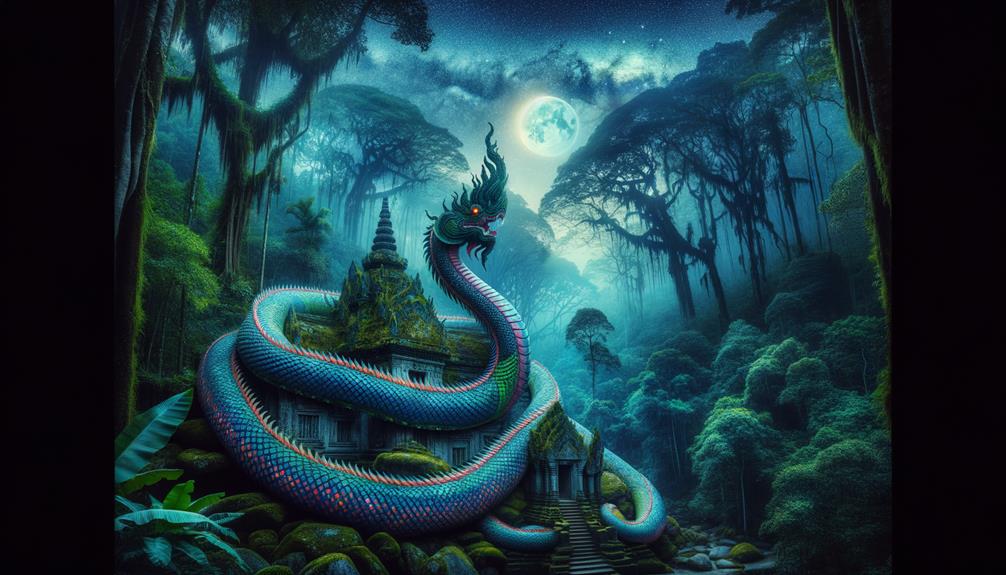On a dream trip to Angkor Wat in Cambodia this year, I was mesmerized by a detailed stone carving of a Naga, a mythical creature with snake-like features. This isn’t just a Cambodia or Buddhist thing; Hindu, Buddhist, and Jain myths also weave Nagas into their stories. These half-human, half-snake beings offer an intriguing mix of possible danger and kindness to humans. They are often thought to live in water environments and protect hidden riches in their underground home, known as Naga-loka or Patala-loka. But there’s more to Naga mythology than just these basic facts, and it’s worth digging deeper (it could just be me since I’m a mythology nerd). Could Nagas reflect our own complex nature, or might they represent something even more profound within these religious narratives?
Understanding the Naga Concept

Diving into the world of Nagas, these mythical beings often appear in the stories and traditions of Hinduism, Buddhism, and Jainism. They’re usually depicted as half-human, half-cobra, with the unique ability to transform between human and snake forms. These creatures are believed to live in an underground world known as Naga-loka or Patala-loka. Here, they have the duty of guarding hidden riches and bodies of water. Their connection with water is a key part of their mythological role, often seen as guardians of various water sources, pointing to their vital role in ancient Indian myths.
In Hindu mythology, Nagas hold a special place. Characters like Shesha, Vasuki, and Takshaka are central to many stories. Shesha, for instance, is said to support Vishnu during the creation of the world, while Vasuki plays a part in the cosmic ocean of milk as a churning rope. These tales highlight the intriguing meld of human and serpent characteristics that define the Naga.
Buddhists hold Nagas in high regard as divine beings. One famous Naga, Mucalinda, is said to have sheltered Buddha during a storm. This act is seen as a reflection of their dedication to safeguard those who have reached enlightenment, further solidifying their status as potent and protective mythical beings. All these elements combine to make the lore of the 42 Nagas a captivating and intricate part of these religions.
Nagas in Hindu Lore

In the Hindu religious texts, it’s written that the Nagas were fathered by the ancient sage Kashyapa. Water is their element of choice, and they’re known to live in an underground realm named Naga-loka. Interestingly, Nagas are also known to guard treasures, which points to their protective role in Hindu mythology.
Let’s take a closer look at some key features of Nagas in Hindu mythology:
- Their dual form: The fascinating thing about Nagas is their ability to switch between human and cobra forms.
- Their connection with water: You’ll often find Nagas associated with water bodies like rivers, lakes, and wells, representing both the nourishing and destructive aspects of water.
- Their role in the Mahabharata: This epic Indian tale wouldn’t be the same without the significant roles played by the Nagas.
- Their interactions with the gods: Famous Nagas like Shesha play crucial roles in supporting gods like Vishnu, underscoring their divine duties.
Buddhist Interpretations of Nagas

Let’s shift our gaze to Buddhism, where Nagas are seen as mighty, semi-divine creatures linked to water and fertility. They are viewed as minor deities with significant influence in Buddhism, often shown as protectors of higher-ranking gods on the holy Mount Sumeru. Their guardian role can be seen in the story of the Naga king Muchalinda, who sheltered the Buddha from a storm, establishing their status as protectors in Buddhist stories.
Asian Buddhist traditions also connect Nagas with fertility and good fortune. This connection is tied to their rule over water bodies, which are thought to be their home. These dwellings can be anything from oceans and streams to rivers and even underground caves. Their snake-like form, accentuated by the famous naga hoods, signifies their power and fertility.
The role of Nagas in safeguarding Buddhist teachings also boosts their significance. Their link with water, often thought of as a life-giving and purifying element, and their care for the Buddha, highlight their critical role in Buddhist tales. Overall, the representation of Nagas in Buddhism uniquely combines divine guardianship, fertility symbols, and fortune-bearing creatures.
Nagas and Jain Traditions

Let’s chat about Nagas in Jain traditions, where they’re held in high regard as divine beings with a special knack for protection and guardianship. This is a theme that pops up quite often in Jain art and mythology, where Nagas are seen as protectors, often depicted shielding Jain practitioners from harm. This is pretty similar to their roles in Hindu and Buddhist mythology, showing a shared respect for these beings across different belief systems.
To give you a snapshot, here are a few interesting points:
- Jain Tirthankara Parshvanatha is typically shown under a canopy of naga hoods, a clear nod to the protective nature of Nagas.
- Staying true to other Asian mythology, female nagas are seen as good luck charms, symbolizing fertility and prosperity.
- Mount Meru, seen as the cosmic axis in Jain cosmology, is thought to be safeguarded by Nagas, cementing their reputation as guardians.
- In South India, Nagas are worshipped as lesser deities, showing how widespread this belief really is.
Taking a closer look at Nagas in Jain traditions gives us a richer understanding of their role and significance. It really drives home the point of how widespread and enduring Naga reverence is in different cultural contexts.
Nagas Versus Medusa: a Comparison

Let’s chat about Nagas and Medusa, two legendary characters from Eastern and Western tales. It’s interesting to see the similarities and contrasts in what they represent and their roles in their respective cultural stories. In Hindu myth, Nagas are part serpent, part god creatures who live in the cosmic ocean. Medusa, meanwhile, is a scary character with snakes for hair who can turn people to stone just by looking at them.
In parts of southern India, Nagas are often linked to natural catastrophes like floods. But they’re not all bad – they also stand for fertility and protection. They can switch between appearing as a human and a more terrifying snake form. Medusa, in contrast, is known for her power to destroy, representing the dangers that wait beyond the boundaries of the known world.
But for all their differences, both these mythical figures have a relationship with water and its symbolic meaning. Nagas are seen as protectors of the cosmic ocean and its hidden riches, stirring its depths with a rope. Medusa’s backstory is also strongly linked with the sea. So, each of these characters gives us a unique look into how different societies view and make sense of the unpredictable, often wild forces of nature.
Frequently Asked Questions
What Is the Origin of the Naga?
You know, I’ve always been intrigued by Nagas. They’re deeply intertwined with religions like Hinduism, Buddhism, and Jainism. Picture them as these fascinating entities that merge the features of a human and a cobra. There’s a popular belief that they came into existence from a sage named Kashyapa and his wife, Kadru. Isn’t that a riveting piece of mythology?
What Is the Myth of the Naga?
So, you’re curious about the Naga myth, right? Well, let’s dive in together! Nagas are often portrayed as these fascinating beings that are part human, part cobra, and are believed to dwell beneath the ground. They have a strong connection with water, are known to guard treasures, and are seen as protectors of deities.
In the context of Hinduism, there’s a special day called Naga-panchami dedicated to celebrating their birth. Isn’t that fascinating? And it’s not just within Hinduism; these intriguing beings are held in high regard across a variety of Asian traditions.
Pretty cool, huh?
What Is a Naga in Greek Mythology?
You know, it’s quite interesting when you delve into the world of Greek mythology. You see, the concept of a Naga doesn’t really exist there. This mythical creature, often depicted as a snake or dragon, is more prevalent in Eastern traditions, particularly within religions such as Hinduism, Buddhism, and Jainism. Now, Greek mythology isn’t short on fantastical beasts, but none of them truly match the particular qualities of a Naga. So, in a nutshell, Greek myths and Nagas? They’re from two entirely different worlds.
What Are the 9 Types of Nagas?
Did you know that in Hindu mythology, there are nine distinct types of Nagas? Let’s have a look at them: Ananta, Vasuki, Shesha, Padma, Mahapadma, Shankha, Kulika, Karkotaka, and Takshaka. Each of these Nagas is unique, with attributes and responsibilities that symbolize different facets of life and the cosmos.

